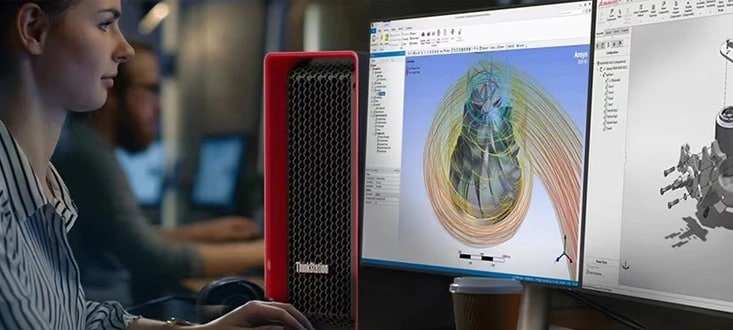12th Generation Intel Core desktop processors
When Intel Corp. launched its first 12th Generation Intel® Core™ processors for desktops in late 2021, it unveiled a new processor architecture aimed at delivering the exact computing power you need exactly when you need it. It's a new approach to optimizing CPU performance—and now, there may be no turning back.
For the first time, Intel's top 12th Gen Core chips split the processor into "efficient" cores (E-cores) and "performance" cores (P-cores). It's what Intel calls a "performance hybrid architecture"1, with the efficient cores handle as many basic computing tasks as possible while the performance cores are reserved for more CPU-intensive work. Each new request is intelligently assigned to where it belongs, with Intel promising big benefits for gaming, content creation, and overall productivity.
You'll find 12th Gen Intel Core processors across the Lenovo desktop and tower line-up. And there's much more to these popular CPUs than their hyper-productive core structure. There's workload optimization software to steer tasks to the right cores; a big jump in available PCIe lanes (many of them PCIe 5.0); support for new, faster memory technology, and more.
12th Gen Intel Core processor architecture
In a way, 12th Gen Intel® Core™ processors organize their work just like we humans. Most of us try to do our simplest work quickly—often all at once—while giving more time and focus to harder tasks. Similarly, 12th Gen Core chips split your requests between their innovative, purpose-driven cores:
- Performance cores (P-cores)—Designed to speedily handle single & lightly-threaded tasks that are best kept within a single core.
- Efficient cores (E-cores)—Designed for highly-threaded workloads that can be shared across multiple cores and be scaled for speed.
Experts call this task splitting and sharing "intelligent workload optimization." Standard OS task schedulers can do some of it, but for its 12th Gen Intel Core processors, the company introduced Intel Thread Director 5.0. It monitors and analyzes real-time performance data to send each application thread to the best available core for that type of work. This helps ensure maximum performance per watt of energy used.2
More PCIe lanes for speedier input/output
At the platform level, 12th Generation Intel® Core™ desktop processors offer multiple innovations that users can feel as they use their PC.
For example, the 12th gen chips offer 20 PCIe lanes—with 16 of them PCIe 5.0, the fastest yet at the time of release. They allow higher-bandwidth peripheral connections to the motherboard, enhancing the performance and responsiveness of everything from discrete graphics to storage drives.
Support for lightning-fast DDR5 memory
Another platform enhancement in 12th Generation Intel Core processors is support for DDR5 memory. And as most PC users know, fast memory can be a game-changer. According to Intel, DDR5 memory can deliver up to 4800 megatransfers per second or MT/s, compared to 3200 MT/s with DDR4.3
If you're unfamiliar with MT/s, it equates to one million transfers per second. It's considered a better way to state memory performance than MHz, which measures memory in terms of the clock cycles of the motherboard.
Overclocking and advanced tuning support
Select 12th Gen Intel® Core™ processors are unlocked, allowing you to unleash additional computing power and performance when needed. Overclocking—which always comes with warnings4—can be useful for gaming, giving you a boost when the competition gets intense. It can also help with tasks like 3D modeling, video editing—anything where you might max-out the processor's typical speed rating.
To help you manage overclocking, 12th Gen Intel Core CPUs provide advanced tuning support through the Intel® Extreme Tuning Utility or Intel XTU. It's software that monitors system performance to help you decide if, and how much, you can overclock.
12th Gen Intel Core desktop processor specifications
Have we whet your appetite for a new PC with a 12th Gen Intel® Core™ desktop processor? The numbers are impressive, as you can see in the specifications in Table 1.
Table 1 Specifications of 12th Generation Intel® Core™ processors at time of announcement (early 2022)
| Feature | Intel Core i9 Processor (Desktop) | Intel Core i7 Processor (Desktop) | Intel Core i5 Processor (Desktop) | Intel Core i3 Processor (Desktop) |
|---|---|---|---|---|
Max Turbo Frequency [GHz] | Up to 5.2 | Up to 5.0 | Up to 4.9 | Up to 4.4 |
Intel® Turbo Boost Max 3.0 Frequency [GHz]5 | Up to 5.2 | Up to 5.0 | n/a | n/a |
Performance Core Max Turbo Frequency [GHz]6 | Up to 5.1 | Up to 4.9 | Up to 4.9 | Up to 4.4 |
Performance Core Base Frequency [GHz] | Up to 3.2 | Up to 3.6 | Up to 3.7 | Up to 3.5 |
Efficient Core Max Turbo Frequency [GHz]6 | Up to 10/20 | Up to 8/16 | Up to 6/12 | Up to 4/8 |
Intel® Hyper-Threading | Up to 3.9 | Up to 3.8 | Up to 3.6 | n/a |
Efficient-Core Base Frequency [GHz] | Up to 2.4 | Up to 2.7 | Up to 2.8 | n/a |
Processor Cores (P-cores + E-cores)7 | 16 (8P+8E) | 12 (8P+4E) | 10 (6P+4E) or 6 (6P+0E)7 | 4 (4P+0E) |
Intel® Hyper-Threading Technology5 | Yes | |||
Total Processor Threads | 24 | 20 | 16 or 127 | 8 |
Intel® Thread Director2 | Yes | Yes | Select7 | No |
Intel® Smart Cache (L3) Size [MB] | 30 | 25 | 20 or 187 | 12 |
Total L2 Cache Size [MB] | 14 | 12 | 9.5 or 7.57 | 5 |
Max Memory Speed [MT/s] | DDR5 4800 | Up to DDR5 4800 | ||
Number of Memory Channels | 2 | |||
CPU PCIe 5.0 Lanes | 16 | |||
CPU PCIe 4.0 Lanes | 4 | |||
So there you have it. 12th Generation Intel® Core™ processors—available across the Lenovo line of desktop and tower PCs— break new ground with a hybrid architecture comprised of P-cores and E-cores. They bring other improvements, too, including more and faster PCIe lanes. There's also support for faster DDR5 memory, and impressive overclocking4 capabilities with tools to help you manage the process.
Intel, the Intel logo, Intel Evo, Intel Core, and Intel vPro are trademarks of Intel Corporation or its subsidiaries.
1 Performance hybrid architecture combines two new core microarchitectures, Performance-cores (P-cores) and Efficient-cores (E-cores), on a single processor die. Select 12th Gen Intel® Core™ processors (certain 12th Generation Intel® Core™ i5 Processors and lower) do not have performance hybrid architecture, only P-cores.
2 Intel® Thread Director is designed into select 12th Gen Intel® Core™ processors and helps support operating systems to more intelligently channel workloads to the right core. No user action required. See intel.com for details.
3 Based on memory bandwidth results using Intel® Memory Latency Checker Tool v3.9a System A: Core i9-12900K on Asus Z690 TUF DDR4 Motherboard. 2x16GB G.Skill TridentZ 3200Mhz CL14 RAM System B: Core i9-12900K on Asus Z690 Prime-P DDR5 Motherboard. 2x16GB SK.Hynix 4400Mhz CL40 RAM.
4 Altering clock frequency or voltage may damage or reduce the useful life of the processor and other system components, and may reduce system stability and performance. Product warranties may not apply if the processor is operated beyond its specifications. Check with the manufacturers of system and components for additional details.
5 Intel® Hyper-Threading Technology and Intel® Turbo Boost Max Technology 3.0 are only available on P-cores.
6 Maximum Performance-core or Efficient-core turbo frequency derived from Intel® Turbo Boost Technology.
7 12th Gen Intel® Core™ i5-12600K and i5-12600KF have 10 total processor cores (6P + 4E); all other 12th Gen Intel® Core™ i5 desktop processors have 6 total processor cores (6P + 0E). Number of processor threads, cache sizes and Intel® Thread Director enablement on 12th Gen Intel® Core™ i5 desktop processors will vary based upon the presence of E-cores.


